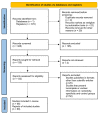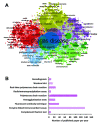Accuracy of Diagnostic Tests for the Detection of Chagas Disease: A Systematic Review and Meta-Analysis
- PMID: 36359595
- PMCID: PMC9689806
- DOI: 10.3390/diagnostics12112752
Accuracy of Diagnostic Tests for the Detection of Chagas Disease: A Systematic Review and Meta-Analysis
Abstract
The present systematic review and meta-analysis about the accuracy of diagnostic tests aim to describe the findings of literature over the last thirty years for the diagnosis of Chagas disease (CD). This work aimed to determine the accuracy of diagnostic techniques for CD in the disease's acute and chronic phases. The PubMed database was searched for studies published between 1990 and 2021 on CD diagnostics. Fifty-six published studies that met the criteria were analyzed and included in the meta-analysis, evaluating diagnostic accuracy through sensitivity and specificity. For Enzyme-Linked Immunosorbent Assay (ELISA), Fluorescent Antibody Technique (IFAT), Hemagglutination Test (HmT), Polymerase Chain Reaction (PCR), and Real-Time Polymerase Chain Reaction (qPCR) diagnosis methods, the sensitivity had a median of 99.0%, 78.0%, 75.0%, 76.0%, and 94.0%, respectively; while specificity presented a median of 99.0%, 99.0%, 99.0%, 98.0%, and 98.0%, respectively. This meta-analysis showed that ELISA and qPCR techniques had a higher performance compared to other methods of diagnosing CD in the chronic and acute phases, respectively. It was concluded utilizing the Area Under the Curve restricted to the false positive rates (AUCFPR), that the ELISA diagnostic test presents the highest performance in diagnosing acute and chronic CD, compared to serological and molecular tests. Future studies focusing on new CD diagnostics approaches should be targeted.
Keywords: Chagas disease; diagnostic tests; meta-analysis; sensitivity and specificity; systematic review.
Conflict of interest statement
The authors declare no conflict of interest.
Figures










Similar articles
-
Evaluating Rabies Test Accuracy: A Systematic Review and Meta-Analysis of Human and Canine Diagnostic Methods.Diagnostics (Basel). 2025 Feb 8;15(4):412. doi: 10.3390/diagnostics15040412. Diagnostics (Basel). 2025. PMID: 40002563 Free PMC article. Review.
-
In vitro diagnostic methods of Chagas disease in the clinical laboratory: a scoping review.Front Microbiol. 2024 Apr 30;15:1393992. doi: 10.3389/fmicb.2024.1393992. eCollection 2024. Front Microbiol. 2024. PMID: 38746745 Free PMC article.
-
A Systematic Review and Meta-Analysis Comparing the Diagnostic Accuracy Tests of COVID-19.Diagnostics (Basel). 2023 Apr 26;13(9):1549. doi: 10.3390/diagnostics13091549. Diagnostics (Basel). 2023. PMID: 37174941 Free PMC article. Review.
-
Nucleic acid and antigen detection tests for leptospirosis.Cochrane Database Syst Rev. 2019 Aug 1;8(8):CD011871. doi: 10.1002/14651858.CD011871.pub2. Cochrane Database Syst Rev. 2019. PMID: 31425612 Free PMC article.
-
Rapid diagnostic tests and ELISA for diagnosing chronic Chagas disease: Systematic revision and meta-analysis.PLoS Negl Trop Dis. 2022 Oct 18;16(10):e0010860. doi: 10.1371/journal.pntd.0010860. eCollection 2022 Oct. PLoS Negl Trop Dis. 2022. PMID: 36256676 Free PMC article.
Cited by
-
Comparison of Four Chimeric Antigens and Commercial Serological Assays for the Diagnosis of Trypanosoma cruzi Infection.Am J Trop Med Hyg. 2024 Oct 29;112(1):89-95. doi: 10.4269/ajtmh.24-0379. Print 2025 Jan 8. Am J Trop Med Hyg. 2024. PMID: 39471517 Free PMC article.
-
Oral Chagas disease outbreak by bacaba juice ingestion: A century after Carlos Chagas' discovery, the disease is still hard to manage.PLoS Negl Trop Dis. 2024 Sep 18;18(9):e0012225. doi: 10.1371/journal.pntd.0012225. eCollection 2024 Sep. PLoS Negl Trop Dis. 2024. PMID: 39292716 Free PMC article.
-
What Do You Need to Know before Studying Chagas Disease? A Beginner's Guide.Trop Med Infect Dis. 2023 Jul 10;8(7):360. doi: 10.3390/tropicalmed8070360. Trop Med Infect Dis. 2023. PMID: 37505656 Free PMC article. Review.
-
Recombinant proteins as promising antigens applied to the immunodiagnosis of Chagas disease: a scoping review.Front Microbiol. 2024 Jul 30;15:1420226. doi: 10.3389/fmicb.2024.1420226. eCollection 2024. Front Microbiol. 2024. PMID: 39139374 Free PMC article.
-
Parasite Burden of Trypanosoma cruzi in Whole Blood and Buffy Coat Determined by Real-Time PCR in Individuals with Chronic Chagas Disease.Microorganisms. 2024 Jan 25;12(2):249. doi: 10.3390/microorganisms12020249. Microorganisms. 2024. PMID: 38399653 Free PMC article.
References
-
- Martínez-Peinado N., Cortes-Serra N., Losada-Galvan I., Alonso-Vega C., Urbina J.A., Rodríguez A., VandeBerg J.L., Pinazo M.-J., Gascon J., Alonso-Padilla J. Emerging agents for the treatment of Chagas disease: What is in the preclinical and clinical development pipeline? Expert Opin. Investig. Drugs. 2020;29:947–959. doi: 10.1080/13543784.2020.1793955. - DOI - PubMed
Publication types
Grants and funding
LinkOut - more resources
Full Text Sources
Miscellaneous

